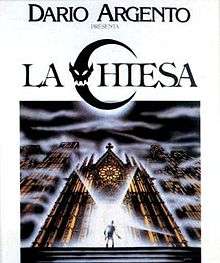The Church (film)
| The Church | |
|---|---|
|
Italian theatrical film poster | |
| Directed by | Michele Soavi |
| Produced by |
Dario Argento Mario Cecchi Gori Vittorio Cecchi Gori |
| Screenplay by |
Dario Argento Michele Soavi Franco Ferrini Dardano Sacchetti (uncredited) Lamberto Bava (uncredited) Fabrizio Bava (prologue) |
| Based on |
The Treasure of Abbot Thomas (short story) by M.R. James |
| Starring |
Hugh Quarshie Tomas Arana Barbara Cupisti Asia Argento Giovanni Lombardo Radice |
| Music by |
Keith Emerson Philip Glass Goblin (as The Goblins) Fabio Pignatelli |
| Cinematography | Renato Tafuri |
| Edited by | Franco Fraticelli |
Production company |
ADC Films Cecchi Gori Group Tiger Cinematografica Reteitalia |
| Distributed by | Cecchi Gori Distribuzione |
Release dates |
|
Running time | 110 minutes |
| Country | Italy |
| Language |
English Italian Hungarian Latin |
| Budget | $3,500,000 (Estimated) |
The Church (Italian title: La chiesa), also known as Cathedral of Demons or Demon Cathedral, is a 1989 Italian horror film directed by Michele Soavi. It was produced by Dario Argento with Mario Cecchi Gori and Vittorio Cecchi Gori, and written by Argento, Soavi, Franco Ferrini, Dardano Sacchetti, Lamberto and Fabrizio Bava.[1] It stars Hugh Quarshie, Tomas Arana, Barbara Cupisti, Asia Argento, Feodor Chaliapin, Jr. and Giovanni Lombardo Radice.[2]
It is the official second sequel to the Dèmoni series, although it has no direct thematic link with the first two parts, and therefore the 1991 horror film Dèmoni 3 (also known as Black Demons) is usually and incorrectly associated as the third film of the saga.
Plot summary
In medieval Germany, the Teutonic Knights massacre a village of supposed "witches" and build the titular structure over their dead bodies. In the present day, the church's new librarian (Tomas Arana) breaks the seal of the crypt out of curiosity and releases the evil spirits contained beneath it. At the same time, the church's automated mechanisms, which were set up by the architect who built the church, are triggered, causing the doors to close and trapping everyone inside, including a group of visitors. Father Gus (Hugh Quarshie), the only person not affected by the demons, eventually finds the way to make the church collapse on itself but dies in the process of doing so. Before the movie ends, Lotte (Asia Argento), the sacristan's daughter and the sole survivor of the incident, is seen walking towards the ruins of the church. She finds the seal of the crypt, opens it and peers inside. Blue light emits from within, just like when the librarian first opened it, and she smiles.
Cast
|
|
Background
The Church was originally conceived as the third film in the Dèmoni series; however, Michele Soavi insisted that the film stand alone and not connected with the first two entries.[3]
Soavi, in an interview with Cinefantastique, explained that he wished to move beyond with his creations following the film's release, and because of that he declined to keep working with Argento as a team.[4]
Soundtrack
The score was composed by prog-rock musician Keith Emerson and by composer Philip Glass. The soundtrack featured tracks from Goblin and Fabio Pignatelli.[5]
Release
The film premiered in Rome on 10 March 1989 and was released in the Italian cinemas on the same day.[6]
Critical reception
In a contemporary review, Variety referred to the film as a "technically proficient but empty horror exercise".[7] The review noted that the musical score by Goblin was The Church's "strongest element."[7]
On review aggregator website Rotten Tomatoes, The Church has an approval rating of 70% based on nine reviews, satisfying the "Fresh" criteria.[8] Allmovie called it a "gothic-drenched apocalyptic nightmare" that builds "a suffocating sense of quiet dread".[9]
References
Footnotes
- ↑ The Films of Michele Soavi
- ↑ Home Cinema @ The Digital Fix - The Church
- ↑ The Church (1988) - The Movie Digital Retribution
- ↑ "This is bullshit!" Interview mit Michele Soavi - Spookie online (German)
- ↑ Michele Soavi The Church Filmkritik Rezension Kritik
- ↑ Eccentric Cinema | THE CHURCH
- 1 2 Prouty 1994: "No page number in the book. Review is dated "February 11, 1991""
- ↑ "La Chiesa (The Church) (Cathedral of Demons) (1989)". Rotten Tomatoes. Retrieved 30 June 2012.
- ↑ Jason Buchanan. "The Church". Allmovie. Retrieved 30 June 2012.
Sources
- Prouty, Howard H., ed. (1994). Variety Television Reviews 1923-1992. Garland Publishing Inc. ISBN 0-8240-3796-0.

